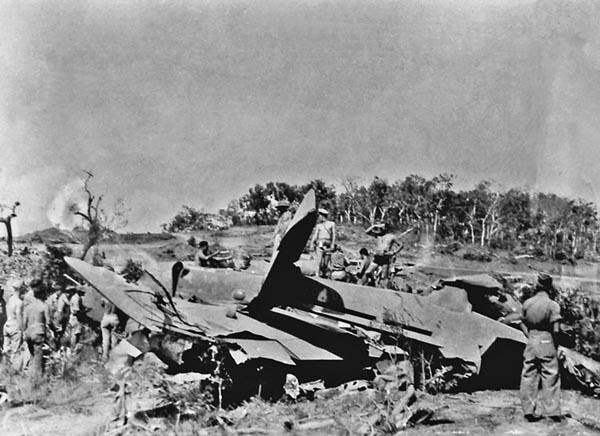The 38th Bomb Group called Horn Island, located north of Queensland, Australia, home in September 1942. Perhaps home is too strong a word. While staying at Horn Island, the men put up with high heat and humidity, hordes of mosquitoes, bad food, lots of dust and a water supply that was tainted with magnesium sulfate. It was not a pleasant area.
In the event of an air raid, all planes were to take off in order to keep damage at a minimum. The dusty conditions significantly hindered pilot visibility, making takeoff very risky. The two runways on Horn Island formed the shape of an ‘X’ and each had a small cutout where pilots of two planes could wait for their turn to taxi to the end of a runway and begin their takeoff.
September 25, 1942 brought a Japanese raid to the island, sending crews running to their planes in order to get them airborne fast. At the time, the 49th Fighter Group was also staying at Horn Island, leading to even more chaos as both P-40 fighters and B-25 bombers began to crowd the two runways. In the midst of the hubbub was the 405th Squadron’s 1/Lt. William F. Pittman and his crew hurrying to get their B-25, SUICIDE’S FLYING DRUNKS off the ground.
Pittman taxied to the end of the runway, then turned around to take off. Because of all the dust that had been kicked up as he taxied, he couldn’t see whether or not the end of the runway was clear. At the same time, a P-40 was taxiing in the opposite direction on the same runway. When Pittman hit 90mph, he exited the dust and saw a collision between his plane and the P-40 was imminent.
Yelling for his crew to hang on, Pittman and his co-pilot, 2/Lt. Dean G. Hall, managed to get a few feet off the ground, with the left landing gear rolling over the top of the P-40. The left wing dropped as the B-25 flew through the camp area, leaving a path of destruction in its wake. Even though Pittman leveled out, SUICIDE’S FLYING DRUNKS was not going fast enough to avoid a crash and the pilot quickly began turning off the engines to prevent a fire on impact.
As he turned off the engines, the plane crashed, throwing the crew around. At the time of the crash, bombardier 2/Lt. Joseph R. Petronis was wearing a steel helmet that probably saved his life; he walked away uninjured with a large dent in it after hitting a bulkhead. Luckily, no one was seriously injured in the crash. SUICIDE’S FLYING DRUNKS was a total loss.



Sometimes, there is fortune in war…
LikeLiked by 1 person
A very lucky Crew. Do we know what happened to the P-40?
LikeLike
According to Peter Dunn’s Oz@War site, it was towed off the runway. Understandably, the pilot of the plane was in complete shock after nearly crashing into the B-25.
LikeLiked by 1 person
I’ll bet he was! Thanks for the answer.
LikeLike
You’re welcome. Glad it was helpful.
LikeLiked by 1 person
I wanted to reblog this but the re-blog button has disappeared. I’ve contacted Support, but who knows when they’ll reply.
LikeLike
Was originally going to reblog one of our older posts, but ran into the same problem you did. Apparently, they’re working on some changes to the button. Someone else asked about it in the comments on their post about the new action bar.
Anyway, thank you for the reblog thought! Hopefully we’ll be able to get back to doing that soon.
LikeLike
Thanks. I’ll get back here!
LikeLike
Wow! That isn’t the kind of story that usually has a very happy ending. Thanks for sharing it with us.
LikeLike
They were pretty lucky!
LikeLike
Wow, that is quite a story. It is incredible all the small, personal stories that exist from World War Two since each person also has their memories and stories. Thank You for sharing. Here is a blog focused on World War Two Tourism, it might interest you: http://www.discoverww2now.wodpress.com
LikeLike
Glad you enjoyed it. Thanks for dropping by and sharing your site!
LikeLiked by 1 person
Pingback: International Historical Research Associates | The crash of Suicide’s Flying Drunks